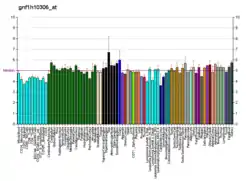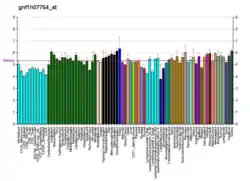GPR111
Probable G-protein coupled receptor 111 is a protein that in humans is encoded by the GPR111 gene.[5][6][7]
| ADGRF2 | |||||||||||||||||||||||||
|---|---|---|---|---|---|---|---|---|---|---|---|---|---|---|---|---|---|---|---|---|---|---|---|---|---|
| Identifiers | |||||||||||||||||||||||||
| Aliases | ADGRF2, PGR20, hGPCR35, GPR111, adhesion G protein-coupled receptor F2 | ||||||||||||||||||||||||
| External IDs | MGI: 2182728 HomoloGene: 45213 GeneCards: ADGRF2 | ||||||||||||||||||||||||
| |||||||||||||||||||||||||
| |||||||||||||||||||||||||
| |||||||||||||||||||||||||
| |||||||||||||||||||||||||
| Orthologs | |||||||||||||||||||||||||
| Species | Human | Mouse | |||||||||||||||||||||||
| Entrez | |||||||||||||||||||||||||
| Ensembl | |||||||||||||||||||||||||
| UniProt | |||||||||||||||||||||||||
| RefSeq (mRNA) | |||||||||||||||||||||||||
| RefSeq (protein) | |||||||||||||||||||||||||
| Location (UCSC) | Chr 6: 47.66 – 47.7 Mb | Chr 17: 42.7 – 42.74 Mb | |||||||||||||||||||||||
| PubMed search | [3] | [4] | |||||||||||||||||||||||
| Wikidata | |||||||||||||||||||||||||
| |||||||||||||||||||||||||
References
- GRCh38: Ensembl release 89: ENSG00000164393 - Ensembl, May 2017
- GRCm38: Ensembl release 89: ENSMUSG00000057899 - Ensembl, May 2017
- "Human PubMed Reference:". National Center for Biotechnology Information, U.S. National Library of Medicine.
- "Mouse PubMed Reference:". National Center for Biotechnology Information, U.S. National Library of Medicine.
- Stacey, edited by Simon Yona, Martin (2010). Adhesion-GPCRs : structure to function. New York: Springer Science+Business Media. ISBN 978-1-4419-7912-4.CS1 maint: extra text: authors list (link)
- Fredriksson R, Lagerstrom MC, Hoglund PJ, Schioth HB (Nov 2002). "Novel human G protein-coupled receptors with long N-terminals containing GPS domains and Ser/Thr-rich regions". FEBS Lett. 531 (3): 407–14. doi:10.1016/S0014-5793(02)03574-3. PMID 12435584. S2CID 7449692.
- "Entrez Gene: GPR111 G protein-coupled receptor 111".
Further reading
- Takeda S, Kadowaki S, Haga T, et al. (2002). "Identification of G protein-coupled receptor genes from the human genome sequence". FEBS Lett. 520 (1–3): 97–101. doi:10.1016/S0014-5793(02)02775-8. PMID 12044878. S2CID 7116392.
- Fredriksson R, Gloriam DE, Höglund PJ, et al. (2003). "There exist at least 30 human G-protein-coupled receptors with long Ser/Thr-rich N-termini". Biochem. Biophys. Res. Commun. 301 (3): 725–34. doi:10.1016/S0006-291X(03)00026-3. PMID 12565841.
- Vassilatis DK, Hohmann JG, Zeng H, et al. (2003). "The G protein-coupled receptor repertoires of human and mouse". Proc. Natl. Acad. Sci. U.S.A. 100 (8): 4903–8. doi:10.1073/pnas.0230374100. PMC 153653. PMID 12679517.
- Mungall AJ, Palmer SA, Sims SK, et al. (2003). "The DNA sequence and analysis of human chromosome 6". Nature. 425 (6960): 805–11. doi:10.1038/nature02055. PMID 14574404.
- Bjarnadóttir TK, Fredriksson R, Höglund PJ, et al. (2005). "The human and mouse repertoire of the adhesion family of G-protein-coupled receptors". Genomics. 84 (1): 23–33. doi:10.1016/j.ygeno.2003.12.004. PMID 15203201.
This article is issued from Wikipedia. The text is licensed under Creative Commons - Attribution - Sharealike. Additional terms may apply for the media files.





